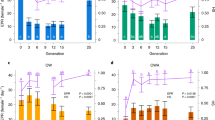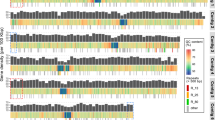Abstract
Although ocean warming and acidification are recognized as two major anthropogenic perturbations of today’s oceans we know very little about how marine phytoplankton may respond via evolutionary change. We tested for adaptation to ocean warming in combination with ocean acidification in the globally important phytoplankton species Emiliania huxleyi. Temperature adaptation occurred independently of ocean acidification levels. Growth rates were up to 16% higher in populations adapted for one year to warming when assayed at their upper thermal tolerance limit. Particulate inorganic (PIC) and organic (POC) carbon production was restored to values under present-day ocean conditions, owing to adaptive evolution, and were 101% and 55% higher under combined warming and acidification, respectively, than in non-adapted controls. Cells also evolved to a smaller size while they recovered their initial PIC:POC ratio even under elevated CO2. The observed changes in coccolithophore growth, calcite and biomass production, cell size and elemental composition demonstrate the importance of evolutionary processes for phytoplankton performance in a future ocean.
This is a preview of subscription content, access via your institution
Access options
Subscribe to this journal
Receive 12 print issues and online access
$209.00 per year
only $17.42 per issue
Buy this article
- Purchase on Springer Link
- Instant access to full article PDF
Prices may be subject to local taxes which are calculated during checkout




Similar content being viewed by others
References
Thomas, M. K., Kremer, C. T., Klausmeier, C. A. & Litchman, E. A. Global pattern of thermal adaptation in marine phytoplankton. Science 338, 1085–1088 (2012).
Falkowski, P. G., Fenchel, T. & Delong, E. F. The microbial engines that drive Earth’s biogeochemical cycles. Science 320, 1034–1039 (2008).
Boyce, D. G., Lewis, M. R. & Worm, B. Global phytoplankton decline over the past century. Nature 466, 591–596 (2010).
Toseland, A. et al. The impact of temperature on marine phytoplankton resource allocation and metabolism. Nature Clim. Change 3, 979–984 (2013).
Boyd, P. W. et al. Marine phytoplankton temperature versus growth responses from polar to tropical waters—outcome of a scientific community-wide study. PLoS ONE 8, e63091 (2013).
Yvon-Durocher, G. et al. Reconciling the temperature dependence of respiration across timescales and ecosystem types. Nature 487, 472–476 (2012).
Boyd, P. W. Beyond ocean acidification. Nature Geosci. 4, 273–274 (2011).
Hofmann, M. & Schellnhuber, H-J. Oceanic acidification affects marine carbon pump and triggers extended marine oxygen holes. Proc. Natl Acad. Sci. USA 106, 3017–3022 (2009).
Caldeira, K. & Wickett, M. E. Oceanography: Anthropogenic carbon and ocean pH. Nature 425, 365 (2003).
Feely, R. A. et al. Impact of anthropogenic CO2 on the CaCO3 system in the oceans. Science 305, 362–366 (2004).
Kroeker, K. J. et al. Impacts of ocean acidification on marine organisms: Quantifying sensitivities and interaction with warming. Glob. Change Biol. 19, 1884–1896 (2013).
Riebesell, U. et al. Reduced calcification of marine plankton in response to increased atmospheric CO2 . Nature 407, 364–367 (2000).
Lohbeck, K. T., Riebesell, U. & Reusch, T. B. H. Adaptive evolution of a key phytoplankton species to ocean acidification. Nature Geosci. 5, 346–351 (2012).
Sett, S. et al. Temperature modulates coccolithophorid sensitivity of growth, photosynthesis and calcification to increasing seawater p CO 2 . PLoS ONE 9, e88308 (2014).
Feng, Y. et al. Interactive effects of increased p CO 2, temperature and irradiance on the marine coccolithophore Emiliania huxleyi (Prymnesiophyceae). Eur. J. Phycol. 43, 87–98 (2008).
Kremp, A. et al. Intraspecific variability in the response of bloom-forming marine microalgae to changed climate conditions. Ecol. Evol. 2, 1195–1207 (2012).
Riebesell, U., Körtzinger, A. & Oschlies, A. Sensitivities of marine carbon fluxes to ocean change. Proc. Natl Acad. Sci. USA 106, 20602–20609 (2009).
Reusch, T. B.H. & Boyd, P. W. Experimental evolution meets marine phytoplankton. Evolution 67, 1849–1859 (2013).
Bell, G. & Gonzalez, A. Adaptation and evolutionary rescue in metapopulations experiencing environmental deterioration. Science 332, 1327–1330 (2011).
Schoener, T. W. The newest synthesis: Understanding the interplay of evolutionary and ecological dynamics. Science 331, 426–429 (2011).
Hoffmann, A. A. & Sgro, C. M. Climate change and evolutionary adaptation. Nature 470, 479–485 (2011).
Kovach-Orr, C. & Fussmann, G. F. Evolutionary and plastic rescue in multitrophic model communities. Phil. Trans. R. Soc. B 368, 20120084 (2013).
Elena, S. F. & Lenski, R. E. Evolution experiments with microorganisms: The dynamics and genetic bases of adaptation. Nature Rev. Genet. 4, 457–469 (2003).
Collins, S. L. & Bell, G. Phenotypic consequences of 1,000 generations of selection at elevated CO2 in a green alga. Nature 431, 566–569 (2004).
Jin, P., Gao, K. & Beardall, J. Evolutionary responses of a coccolithophorid Gephyrocapsa oceanica to ocean acidification. Evolution 67, 1869–1878 (2013).
Paasche, E. A review of the coccolithophorid Emiliania huxleyi (Prymnesiophyceae), with particular reference to growth, coccolith formation, and calcification–photosynthesis interactions. Phycologia 40, 503–529 (2002).
Armstrong, R. A., Lee, C., Hedges, J. I., Honjo, S. & Wakeham, S. G. A new, mechanistic model for organic carbon fluxes in the ocean based on the quantitative association of POC with ballast minerals. Deep-Sea Res. II 49, 219–236 (2001).
Brand, L. E. Genetic variability and spatial patterns of genetic differentiation in the reproductive rates of the marine coccolithophores Emiliania huxleyi and Gephyrocapsa oceanica. Limnol. Oceanogr. 27, 236–245 (1982).
Collins, S. Many possible worlds: Expanding the ecological scenarios in experimental evolution. Evol. Biol. 38, 3–14 (2011).
Daufresne, M., Lengfellner, K. & Sommer, U. Global warming benefits the small in aquatic ecosystems. Proc. Natl Acad. Sci. USA 106, 12788–12793 (2009).
Atkinson, D., Ciotti, B. J. & Montagnes, D. J. S. Protists decrease in size linearly with temperature: ca. 2.5% °C−1. Proc. R. Soc. Lond. B 270, 2605–2611 (2003).
Rokitta, S. D., John, U. & Rost, B. Ocean acidification affects redox-balance and ion-homeostasis in the life-cycle stages of Emiliania huxleyi. PLoS ONE 7, e52212 (2012).
Bach, L. T. et al. An approach for particle sinking velocity measurements in the 3–400 μm size range and considerations on the effect of temperature on sinking rates. Mar. Biol. 159, 1853–1864 (2012).
Sterner, R. & Elser, J. in The Princeton Guide to Ecology (eds Levin, S. A. et al.) 376–385 (Princeton Univ. Press, 2009).
Rizhsky, L. et al. When defense pathways collide: The response of Arabidopsis to a combination of drought and heat stress. Plant Physiol. 134, 1683–1696 (2004).
Pena-Miller, R. et al. When the most potent combination of antibiotics selects for the greatest bacterial load: The smile–frown transition. PLoS Biol. 11, e1001540 (2013).
Lenski, R., Rose, M., Simpson, S. & Tadler, S. Long-term experimental evolution in Escherichia coli. I. Adaptation and divergence during 2,000 generations. Am. Nat. 138, 1315–1341 (1991).
Etterson, J. R. & Shaw, R. G. Constraint to adaptive evolution in response to global warming. Science 294, 151–154 (2001).
Weinreich, D. M., Watson, R. A. & Chao, L. Perspective: Sign epistasis and genetic constraint on evolutionary trajectories. Evolution 59, 1165–1174 (2005).
Wood, A. M. & Leatham, T. The species concept in phytoplankton ecology. J. Phycol. 28, 723–729 (1992).
Zhang, Y. et al. Between- and within-population variations in thermal reaction norms of the coccolithophore Emiliania huxleyi. Limnol. Oceanogr. 59, 1570–1580 (2014).
Lohbeck, K. T., Riebesell, U., Collins, S. & Reusch, T. B. H. Functional genetic divergence in high CO2 adapted Emiliania huxleyi populations. Evolution 67, 1892–1900 (2013).
Lang, G. I. et al. Pervasive genetic hitchhiking and clonal interference in forty evolving yeast populations. Nature 500, 571–574 (2013).
Orr, H. A. The genetic theory of adaptation: A brief history. Nature Rev. Genet. 6, 119–127 (2005).
Moran, X. A. G., Lopez-Urrutia, Á., Calvo-Díaz, A. & Li, W. K. W. Increasing importance of small phytoplankton in a warmer ocean. Glob. Change Biol. 16, 1137–1144 (2010).
Härnström, K., Ellegaard, M., Andersen, T. J. & Godhe, A. Hundred years of genetic structure in a sediment revived diatom population. Proc. Natl Acad. Sci. USA 108, 4252–4257 (2011).
Collins, S., Rost, B. & Rynearson, T. A. Evolutionary potential of marine phytoplankton under ocean acidification. Evol. Appl. 7, 140–155 (2014).
Acknowledgements
We thank R. Ebbinghaus, K. Beining, J. Meyer, S. Audritz, D. Gill, A. Ludwig and K. Nachtigall for laboratory assistance. This project was funded by the Kiel Cluster of Excellence ‘Future Ocean’ and the BMBF project ‘Biological Impacts of Ocean Acidification’ (BIOACID). Comments by B. Matthiessen improved earlier versions of the manuscript.
Author information
Authors and Affiliations
Contributions
L.S., T.B.H.R., U.R. and K.T.L. planned the experiment, L.S. conducted the experiment. L.S. collected data. J.P.G. contributed statistical analyses. L.S., K.T.L., M.A.G., U.R. and T.B.H.R. analysed and interpreted the results. T.B.H.R. wrote the paper.
Corresponding author
Ethics declarations
Competing interests
The authors declare no competing financial interests.
Supplementary information
Rights and permissions
About this article
Cite this article
Schlüter, L., Lohbeck, K., Gutowska, M. et al. Adaptation of a globally important coccolithophore to ocean warming and acidification. Nature Clim Change 4, 1024–1030 (2014). https://doi.org/10.1038/nclimate2379
Received:
Accepted:
Published:
Issue Date:
DOI: https://doi.org/10.1038/nclimate2379
This article is cited by
-
Plastic responses lead to increased neurotoxin production in the diatom Pseudo-nitzschia under ocean warming and acidification
The ISME Journal (2023)
-
Combination of RNAseq and RADseq to Identify Physiological and Adaptive Responses to Acidification in the Eastern Oyster (Crassostrea virginica)
Marine Biotechnology (2023)
-
Malformation in coccolithophores in low pH waters: evidences from the eastern Arabian Sea
Environmental Science and Pollution Research (2023)
-
Increased genetic diversity loss and genetic differentiation in a model marine diatom adapted to ocean warming compared to high CO2
The ISME Journal (2022)
-
Contemporary evolution rivals the effects of rhizobium presence on community and ecosystem properties in experimental mesocosms
Oecologia (2022)



